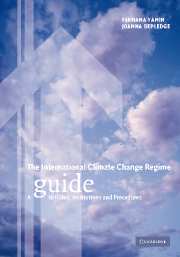Book contents
- Frontmatter
- Contents
- List of figures
- List of tables
- List of boxes
- Foreword by Joke Waller Hunter, Executive Secretary, FCCC
- Preface and acknowledgements
- List of abbreviations
- 1 Introduction
- 2 Overview
- 3 Regime participants
- 4 Objective and principles
- 5 Mitigation commitments
- 6 Flexibility mechanisms
- 7 Research, systematic observation, education, training and public awareness
- 8 Adaptation
- 9 Impacts of response measures
- 10 Finance, technology and capacity-building
- 11 Reporting and review
- 12 Compliance
- 13 Institutions
- 14 The negotiation process
- 15 Scientific and technical input
- 16 Administering the regime
- 17 Linkages
- 18 Evolution of the regime
- 19 Conclusion: taking stock and moving forward
- Appendix I List of Parties, their groups and key statistics
- Appendix II Annex I Party fact sheets: emissions, targets and projections for Annex I Parties and groupings
- Appendix III Table of Articles, issues and COP Decisions
- Bibliography
- Index
5 - Mitigation commitments
Published online by Cambridge University Press: 16 July 2009
- Frontmatter
- Contents
- List of figures
- List of tables
- List of boxes
- Foreword by Joke Waller Hunter, Executive Secretary, FCCC
- Preface and acknowledgements
- List of abbreviations
- 1 Introduction
- 2 Overview
- 3 Regime participants
- 4 Objective and principles
- 5 Mitigation commitments
- 6 Flexibility mechanisms
- 7 Research, systematic observation, education, training and public awareness
- 8 Adaptation
- 9 Impacts of response measures
- 10 Finance, technology and capacity-building
- 11 Reporting and review
- 12 Compliance
- 13 Institutions
- 14 The negotiation process
- 15 Scientific and technical input
- 16 Administering the regime
- 17 Linkages
- 18 Evolution of the regime
- 19 Conclusion: taking stock and moving forward
- Appendix I List of Parties, their groups and key statistics
- Appendix II Annex I Party fact sheets: emissions, targets and projections for Annex I Parties and groupings
- Appendix III Table of Articles, issues and COP Decisions
- Bibliography
- Index
Summary
Introduction
The timing and stringency of mitigation commitments, and which Parties or groups of Parties should undertake them, lies at the heart of the climate regime. This chapter sets out the mitigation commitments agreed to date in relation to sources, sinks and reservoirs of GHGs. These, and other related mitigation terms, are explained in box 5.1 below. The provisions of the FCCC and the Kyoto Protocol are, of course, the most important source of rules in respect of GHG mitigation commitments. In each section the rules contained in the FCCC and KP are set out first, followed by a ‘rule development’ section which sets out how these rules have been further elaborated, defined or enhanced as a result of COP decisions. Customary international law and general principles of law help define the rights and responsibilities of states in respect of global environmental problems such as climate change and are discussed in chapter 1.
The mitigation commitments applicable to all Parties are found in Article 4.1 of the Convention. Informally, these are called ‘general commitments’ because Article 4.1 covers a broad range of issues relevant to addressing climate change, including planning, research and adaptation. The more stringent mitigation commitments of Annex I Parties are contained in Article 4.2 of the Convention and these are often termed ‘specific commitments’. These are covered in detail in section 5. Articles 4.3 to 4.10 of the Convention contain commitments relating to the special situations of particular groups of countries, including EITs, developing countries and Parties dependent on the production/consumption of fossil fuels.
- Type
- Chapter
- Information
- The International Climate Change RegimeA Guide to Rules, Institutions and Procedures, pp. 74 - 135Publisher: Cambridge University PressPrint publication year: 2004



